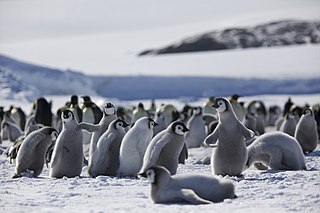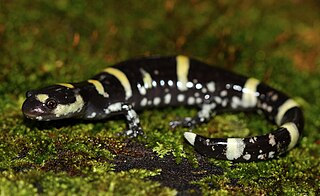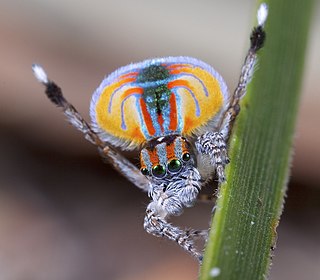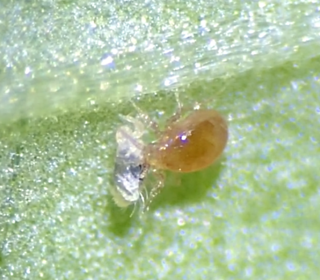Related Research Articles

Amblypygi is an ancient order of arachnid chelicerate arthropods also known as African cave-dwelling spiders, whip spiders and tailless whip scorpions. The name "amblypygid" means "blunt tail", a reference to a lack of the flagellum that is otherwise seen in whip scorpions. Amblypygids possess no silk glands or venomous fangs. They rarely bite if threatened, but can grab fingers with their pedipalps, resulting in thorn-like puncture injuries.

Behavioral ecology, also spelled behavioural ecology, is the study of the evolutionary basis for animal behavior due to ecological pressures. Behavioral ecology emerged from ethology after Niko Tinbergen outlined four questions to address when studying animal behaviors: What are the proximate causes, ontogeny, survival value, and phylogeny of a behavior?

Plethodontidae, or lungless salamanders, are a family of salamanders. Most species are native to the Western Hemisphere, from British Columbia to Brazil, although a few species are found in Sardinia, Europe south of the Alps, and South Korea. In terms of number of species, they are by far the largest group of salamanders.

The ringed salamander is a species of mole salamander native to hardwood and mixed hardwood-pine forested areas in and around the Ozark Plateau and Ouachita Mountains of Arkansas, Oklahoma, and Missouri.

Maratus volans is a species in the jumping spider family (Salticidae), belonging to the genus Maratus. These spiders are native to certain areas in Australia and occupy a wide distribution of habitats. They have a specialized visual system that allows them to see the full visible spectrum as well as in the UV-range; this helps them detect and pursue prey. Males of this species are characterized by their colorful abdomen flaps that are used to attract females during courtship.

Sexual conflict or sexual antagonism occurs when the two sexes have conflicting optimal fitness strategies concerning reproduction, particularly over the mode and frequency of mating, potentially leading to an evolutionary arms race between males and females. In one example, males may benefit from multiple matings, while multiple matings may harm or endanger females, due to the anatomical differences of that species. Sexual conflict underlies the evolutionary distinction between male and female.

Teleogryllus oceanicus, commonly known as the Australian, Pacific or oceanic field cricket, is a cricket found across Oceania and in coastal Australia from Carnarvon in Western Australia and Rockhampton in north-east Queensland

Mate choice is one of the primary mechanisms under which evolution can occur. It is characterized by a "selective response by animals to particular stimuli" which can be observed as behavior. In other words, before an animal engages with a potential mate, they first evaluate various aspects of that mate which are indicative of quality—such as the resources or phenotypes they have—and evaluate whether or not those particular trait(s) are somehow beneficial to them. The evaluation will then incur a response of some sort.

Sexual cannibalism is when an animal, usually the female, cannibalizes its mate prior to, during, or after copulation. It is a trait observed in many arachnid orders and several insect orders. Several hypotheses to explain this seemingly paradoxical behavior have been proposed. The adaptive foraging hypothesis, aggressive spillover hypothesis and mistaken identity hypothesis are among the proposed hypotheses to explain how sexual cannibalism evolved. This behavior is believed to have evolved as a manifestation of sexual conflict, occurring when the reproductive interests of males and females differ. In many species that exhibit sexual cannibalism, the female consumes the male upon detection. Females of cannibalistic species are generally hostile and unwilling to mate; thus many males of these species have developed adaptive behaviors to counteract female aggression.

The Phytoseiidae are a family of mites which feed on thrips and other mite species. They are often used as a biological control agent for managing mite pests. Because of their usefulness as biological control agents, interest in Phytoseiidae has steadily increased over the past century. Public awareness of the biological control potential of invertebrates has been growing, though mainly in the US and Europe. In 1950, there were 34 known species. Today, there are 2,731 documented species organized in 90 genera and three subfamilies.

The ocoee salamander is a species of salamander in the family Plethodontidae. This salamander has a variety of colors and patterns, and got its name from Tennessee state wildflower. Its natural habitats are temperate forests, rivers, intermittent rivers, freshwater springs and wet rocks in mountainous areas of the Southeastern United States. It was first described by Nicholls in 1949.
In the evolutionary biology of sexual reproduction, operational sex ratio (OSR) is the ratio of sexually competing males that are ready to mate to sexually competing females that are ready to mate, or alternatively the local ratio of fertilizable females to sexually active males at any given time. This differs from physical sex ratio which simply includes all individuals, including those that are sexually inactive or do not compete for mates.
The Raphignathoidea is a superfamily of the Acari (mite) order Trombidiformes, comprising 1087 species in 62 genera and 12 families.

Lorryia formosa, commonly known as the yellow mite or the citrus yellow mite, is a species of acariform mite. They are in the subfamily Tydeinae of the family Tydeidae. Commonly found on the foliage of citrus trees around the world, Lorryia formosa also associates with a variety of other plant types. The life cycle includes six discrete stages of development, and the lifespan averages about 37 days. The females of the species use an asexual form of reproduction where the growth and development of embryos occurs without fertilization by a male, a process called thelytoky.

Hydrachnidia, also known as "water mites", Hydrachnidiae, Hydracarina or Hydrachnellae, are among the most abundant and diverse groups of benthic arthropods, composed of 6,000 described species from 57 families. As water mites of Africa, Asia, and South America have not been well-studied, the numbers are likely to be far greater. Other taxa of parasitengone mites include species with semi-aquatic habits, but only the Hydracarina are properly subaquatic. Water mites follow the general Parasitengona life cycle: active larva, inactive (calyptostasic) protonymph, active deutonymph, inactive tritonymph and active adult. Usually, larvae are parasites, while deutonymphs and adults are predators.
Corynopoma riisei, also known as the sword-tail characin is a species of characin found in Colombia, Trinidad and Tobago and Venezuela. It is also kept as an aquarium fish. This species is the only member of its genus.
A nuptial gift is a nutritional gift given by one partner in some animals' sexual reproduction practices.

Sexual selection in amphibians involves sexual selection processes in amphibians, including frogs, salamanders and newts. Prolonged breeders, the majority of frog species, have breeding seasons at regular intervals where male-male competition occurs with males arriving at the waters edge first in large number and producing a wide range of vocalizations, with variations in depth of calls the speed of calls and other complex behaviours to attract mates. The fittest males will have the deepest croaks and the best territories, with females making their mate choices at least partly based on the males depth of croaking. This has led to sexual dimorphism, with females being larger than males in 90% of species, males in 10% and males fighting for groups of females.
Stigmaeidae is a family of prostigmatan mites in the order Trombidiformes. At over 600 species, it is the largest family in superfamily Raphignathoidea. It has a worldwide distribution.

Kiwalges haastii is a species of New Zealand feather mite in the superfamily Analgoidea, known only from the great spotted kiwi, from which it derives its name.
References
- 1 2 Alcock, John (1 July 2013). Animal Behaviour: A Evolutionary Approach (10th ed.). Sinauer. pp. 70–72. ISBN 9780878939664.
- ↑ Marshall, Ruth (1922). "The American water mites of the Genus Neumania". Transactions of the Wisconsin Academy of Sciences, Arts and Letters. 20: 205–213.
- 1 2 3 4 5 6 Conroy, John C. (1992). "A Revision Of The Species Of The Genus Neumania Sensu Stricto In North America, With Descriptions Of Seven New Species (Third Part)". Acarologia. 33 (1): 91–101.
- ↑ McAlpine, Donald F.; Smith, Ian M. (1 January 2010). Assessment of Species Diversity in the Atlantic Maritime Ecozone. NRC Research Press. p. 296. ISBN 9780660198354.
- 1 2 3 4 5 Proctor, Heather C. (1992). "Discord between field and laboratory sex ratios of the water mite Neumania papillator Marshall (Acari: Unionicolidae)". Canadian Journal of Zoology . 70 (12): 2483–2486. doi:10.1139/z92-332. ISSN 0008-4301.
- 1 2 3 4 5 6 7 8 9 10 11 Proctor, Heather C. (1 October 1991). "Courtship in the water mite Neumania papillator: males capitalize on female adaptations for predation". Animal Behaviour. 42 (4): 589–598. doi:10.1016/S0003-3472(05)80242-8. S2CID 53166756.
- 1 2 3 4 5 6 7 Proctor, Heather C. (1 October 1992). "Sensory exploitation and the evolution of male mating behaviour: a cladistic test using water mites (Acari: Parasitengona)". Animal Behaviour. 44 (4): 745–752. doi:10.1016/S0003-3472(05)80300-8. S2CID 54426553.
- 1 2 Proctor, H. C. (1 January 1992). "Effect of Food Deprivation on Mate Searching and Spermatophore Production in Male Water Mites (Acari: Unionicolidae)". Functional Ecology. 6 (6): 661–665. doi:10.2307/2389961. JSTOR 2389961.
- ↑ Proctor, Heather Coreen; Wilkinson, Karen (2001). "Coercion and deceit: water mites (Acari: Hydracarina) and the study of intersexual conflict". Acarology: Proceedings of the 10th International Congress. hdl:10072/1376.